In the 1880s a wider range of foods became available to people living in cities, allowing restaurant menus to became more varied. Cold storage warehouses and refrigerated rail cars brought cheaper Chicago beef and out-of-season produce. Mechanically frozen ice, free from the impurities of lake ice, became available. Cheese and butter, once made on farms, now came from factories. Fresh fruits and vegetables remained luxuries for most people, however, and meat and potatoes dominated menus.
Larger, better capitalized restaurants installed electric plants that provided brighter lighting and badly needed ventilation systems.
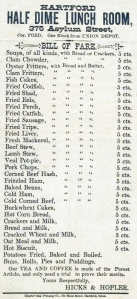 The public demanded, and began to get, lower restaurant prices, quicker service, and more flexible meal times. The dining public expanded. Boarding houses that furnished meals as part of the rent were replaced by kitchenless rooming houses whose residents went to restaurants for dinner. More hotels switched to the European plan, freeing guests to eat wherever they chose rather than pay an inclusive charge for room and meals. New types of ready-to-eat food purveyors came on the scene, such as all-night lunch wagons and dairy cafes that specialized in simple, inexpensive meals such as baked beans and cereal with milk.
The public demanded, and began to get, lower restaurant prices, quicker service, and more flexible meal times. The dining public expanded. Boarding houses that furnished meals as part of the rent were replaced by kitchenless rooming houses whose residents went to restaurants for dinner. More hotels switched to the European plan, freeing guests to eat wherever they chose rather than pay an inclusive charge for room and meals. New types of ready-to-eat food purveyors came on the scene, such as all-night lunch wagons and dairy cafes that specialized in simple, inexpensive meals such as baked beans and cereal with milk.
New ethnic groups arrived on American shores, among them Eastern European Jews and Southern Italians. Many settled in the East but others spread to cities throughout the westward-growing nation. They brought with them new cuisines, tempting the more adventurous eaters among the settled population.
Temperance coffee houses and soda fountains continued to thrive, particularly in Boston where authorities were always looking for ways to curb drinking.
As the rise of department stores and downtown retail shops brought women into city centers, restaurants catering specifically to them appeared on the scene.
But not everyone was welcome at restaurant tables, or in the society at large. Southern states made segregation the law, keeping Black Americans out of white-owned restaurants. Racially motivated legislation cut off Chinese immigration to the U.S. and encouraged hostility toward Chinese already in the country, mostly in the West, motivating many to move eastward and introduce curious diners to new foods.
Highlights
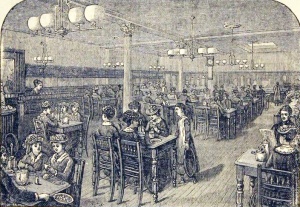 1880 On the second floor of its newly expanded NYC department store, Macy’s restaurant for shoppers seats 200. [pictured] – In the silver-mining town of Virginia City NV, restaurants serve food from all over the world, including “fruits from every country and clime.”
1880 On the second floor of its newly expanded NYC department store, Macy’s restaurant for shoppers seats 200. [pictured] – In the silver-mining town of Virginia City NV, restaurants serve food from all over the world, including “fruits from every country and clime.”
1881 In December, Edmund Hill, proprietor of Hill’s confectionery restaurant in Trenton NJ totals up the proceeds of what he calls a “very satisfactory” year in which the business took in $18,146, netting him the handsome sum of $677.33 in wages and profit.
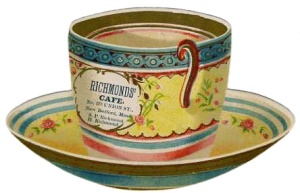 1882 Richmond’s Café in New Bedford MA informs customers that “The Café will be in charge of a lady . . . who will bestow especial pains upon lady patrons, taking charge of whatever parcels may be left in her care while the owners are out shopping.” – In Boston Charles Eaton and a partner open a temperance soda fountain and lunch room called Thompson’s Spa which goes on to become a local institution.
1882 Richmond’s Café in New Bedford MA informs customers that “The Café will be in charge of a lady . . . who will bestow especial pains upon lady patrons, taking charge of whatever parcels may be left in her care while the owners are out shopping.” – In Boston Charles Eaton and a partner open a temperance soda fountain and lunch room called Thompson’s Spa which goes on to become a local institution.
1883 One year after passage of the Chinese Exclusion Act, the Rockaway Oyster and Chop House in Fresno CA advertises to prospective customers that it has “all white help.” Everyone, of course, understands that white means “not Asian.”
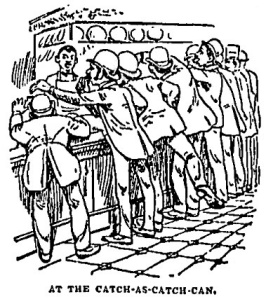 1885 In Boston and other large cities customers flood into cheap restaurants near railroad depots and wharves for 10-cent noon meals. Menus are chalked up on boards and customers eat rapidly without removing coats or hats.
1885 In Boston and other large cities customers flood into cheap restaurants near railroad depots and wharves for 10-cent noon meals. Menus are chalked up on boards and customers eat rapidly without removing coats or hats.
1886 It is considered newsworthy when a federal judge orders a restaurant in Little Rock AR to serve a Black juror along with his fellow white jurors. A report notes that it was “the first time a negro enjoyed his repast at the leading hotel in the state and among white people.”
1887 After gathering menus from 40 prominent hotels from all over the country, a collector determines that salmon is the fish most often listed, and that it is found on menus across the United States, including Knoxville TN, Detroit MI, Milwaukee WI, Salt Lake City UT, and Cheyenne WY.
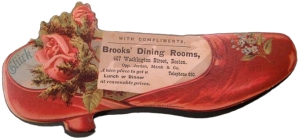 1888 At Chicago’s New York Kitchen, where a nickel buys Ham and Beans Boston Style or “One-third of a Pie, any kind,” the dining room is lighted by a Mather Incandescent Electric System and cooled by a steam-powered exhaust fan. — In Boston Brooks’ Dining Rooms is equipped with a telephone.
1888 At Chicago’s New York Kitchen, where a nickel buys Ham and Beans Boston Style or “One-third of a Pie, any kind,” the dining room is lighted by a Mather Incandescent Electric System and cooled by a steam-powered exhaust fan. — In Boston Brooks’ Dining Rooms is equipped with a telephone.
© Jan Whitaker, 2016

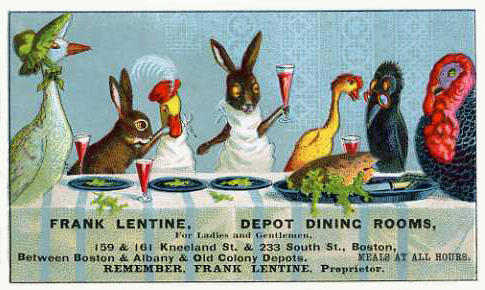








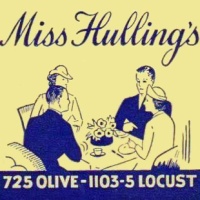
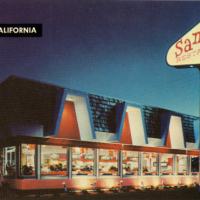
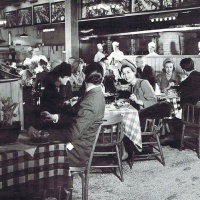
 It's great to hear from readers and I take time to answer queries. I can't always find what you are looking for, but I do appreciate getting thank yous no matter what the outcome.
It's great to hear from readers and I take time to answer queries. I can't always find what you are looking for, but I do appreciate getting thank yous no matter what the outcome.



Pingback: Taste of a decade: 1880s restaurants | Restaurant-ing through history | First Night History
Enjoyed this post! Especially the vintage photos 🙂
What a fascinating post – what I am curious to know is what socio-economic groups of US citizens took to dining at restaurants when they were NOT traveling?
I am also curious about the entry for 1883 implying that Asians were not employed in the restaurant kitchens in any capacity – were (white) customers thought to be afraid of food/utensils which had been handled by Asians?
I am now going to start doing a little digging into the history of restaurants here in China – I already know of two restaurants here in Beijing which have a 350yr old pedigree;
Your illustrations are a delight, as well as being informative!
I would say that the largest group of people who ate in restaurants in the 19th century were single working men who lived in rooms (not regular households). Also, men who were away from home during the day. As for the rejection of Asian restaurant workers, there may have been fears they were unsanitary but mostly it was a sadly familiar kind of anti-immigrant sentiment that saw them as competitors who took away jobs and caused wages to fall. Have fun with your research!
Interesting post Jan. What was the name of the person who collected 40 menus in 1887 and where did he or she report their findings?
Thanks, Henry. The name of the collector was not mentioned in the story I read, which appeared in the NYT June 13, 1887 (and somewhat later in other papers) as “American Hotel Fare.” It originated in the Hartford Courant but I don’t have access to that digitized collection. Apparently that was in May, and the headline could have been different.
As you know, such first-hand observations are virtually impossible to find. You’re the best Jan. Thanks!
I know — I dream of finding diaries that go into detail about restaurants. Hardly ever happens.
Great post as always.:) thanks.
Sent from my iPhone
>
You wouldn’t happen to have anything regarding 1880s restaurants in the West, would you? Denver, Colorado Springs, points west? Thanks!
I do, but what are you looking for exactly?
Pingback: Taste of a decade: 1880s restaurants — Restaurant-ing through history – Restaurant Santa Lucia